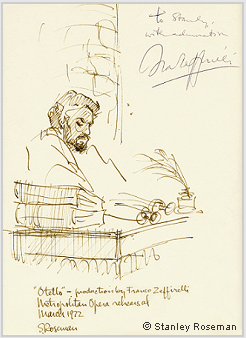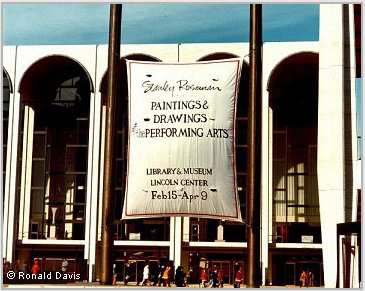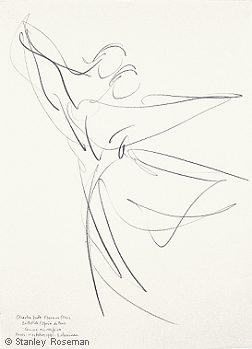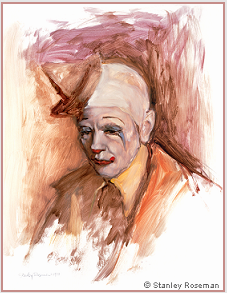
BIOGRAPHY
''STANLEY ROSEMAN combines an innate artistic talent, expressed through a wide range of techniques, with a profound interest in the human condition in portraying different kinds of people, professions, social or artistic groups. With a seriousness that pushes him always further in treating a subject or theme, he continually clarifies and refines, never letting his interest waiver or diminish.''
- Bibliothèque Nationale de France
Stanley Roseman's work has received wide critical acclaim, as with laudatory reviews in The New York Times and The Times, London, and is represented in important museums and private collections. Recognized as a master draughtsman, Roseman was honored in 1983 as the first American artist to be given a one-man exhibition at the Graphische Sammlung Albertina, Vienna's world-renowned museum of master drawings.
From Roseman's oeuvre on the dance is the sublime drawing of Paris Opéra star dancers Florence Clerc and Charles Jude in performance in the pas de deux created for them and entitled Comme on respire, reproduced below, (fig. 11).
The romantic pas de deux was choreographed by the distinguished director and choreographer Eugene Polyakov, a compatriot of Rudolf Nureyev, who as Director of the Dance of the Paris Opéra had invited his colleague to be Ballet Master.
''Stanley Roseman's drawings show the many facets of his great talents as a draughtsman.''[5]
- Bibliothèque Nationale de France
11. Charles Jude and Florence Clerc, 1991
Paris Opéra Ballet
Comme on respire
Pencil on paper, 37.5 x 27.5 cm
Uffizi, Gabinetto Disegni e Stampe,
Florence
Paris Opéra Ballet
Comme on respire
Pencil on paper, 37.5 x 27.5 cm
Uffizi, Gabinetto Disegni e Stampe,
Florence
Stanley Roseman drawing the dance from the wings of the stage of the Paris Opéra
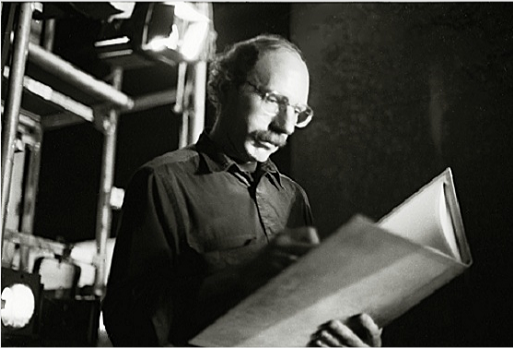
© Photo by Ronald Davis
© Stanley Roseman and Ronald Davis - All Rights Reserved
Visual imagery and website content may not be reproduced in any form whatsoever.
Visual imagery and website content may not be reproduced in any form whatsoever.
Through the nineteenth and twentieth centuries, a number of artists in France sought their imagery from the world of the performing arts. The dance holds a preeminent place in the cultural tradition of France and is an important subject in art, as seen in works by Ingres, Corot, Carpeaux, Manet, Degas, Rodin, Renoir, Bourdelle, Toulouse-Lautrec, Bakst, Matisse, Picasso, Chagall, and Roseman.
Roseman's great interest in the performing arts as a subject for his work brings to mind a French sensibility. The exhibition catalogue Les Arts du Théâtre de Watteau à Fragonard, Musée des Beaux-Arts, Bordeaux, states that the art of the eighteenth century in France was "strongly identified with the world of the theatre," ("profondément marqués par l'univers du théâtre"), with depictions of actors, dancers, singers, and musicians, including the amusing cast of characters of the troupes of the popular commedia dell'arte.[3]
The exciting world of the performing arts is a major theme in Roseman's oeuvre. In his early career in New York City in the 1970's, Roseman was invited by leading opera, theatre, and dance companies to draw at dress rehearsals and performances. The artist drew celebrated singers, actors, and dancers, as well as supporting players, members of the chorus, and the corps de ballet, in a spectrum of memorable cultural events of the time.
5. Frosty Little, 1977
Director of Clowns
Ringling Bros. and Barnum & Bailey Circus
Oil on Strathmore paper, 73 x 58 cm
Musée des Beaux-Arts, Bordeaux
Director of Clowns
Ringling Bros. and Barnum & Bailey Circus
Oil on Strathmore paper, 73 x 58 cm
Musée des Beaux-Arts, Bordeaux
"The Saami paintings are magnificent.''
- The Times, London
6. Bier An'te (detail), 1976
Reindeer Herder, Lappland
Oil on canvas, 98 x 80 cm
Collection of the artist
Reindeer Herder, Lappland
Oil on canvas, 98 x 80 cm
Collection of the artist
''No one, I believe, in 1,500 years of Christian monachism has catalogued, defined and described so clearly or so beautifully the business of the monastic life. No writer, no sculptor, no painter, no architect has refined a distillation so pure, so accurate, so breathtakingly clear as Roseman has done.''
- The Times, London
The Parisian daily La Croix writes in an enthusiastic article on the work of Stanley Roseman:
"He found again in the hospitality of the monasteries what he found in the Saami camps and under the circus tents. Is there not a profound relationship between the migrations of nomads, the voyages of traveling players, and the inner journey which is the contemplative life."
- La Croix, Paris
7. Two Monks Bowing in Prayer, 1979
Abbaye de Solesmes, France
Chalks on paper, 35 x 50 cm
National Gallery of Art, Washington, D.C.
Abbaye de Solesmes, France
Chalks on paper, 35 x 50 cm
National Gallery of Art, Washington, D.C.
- The New York Times
1. Stanley Roseman - Dessins sur la Danse à l'Opéra de Paris (text in French and English),
(Paris: Bibliothèque Nationale de France, 1996), p.12.
2. Ibid., p. 12.
4. Stanley Roseman - Dessins sur la Danse à l'Opéra de Paris (text in French and English),
"Quelques Mots des Danseurs" / "A Few Words from the Dancers," Florence Clerc,
Paris: Bibliothèque Nationale de France, 1996, pp. 14, 15.
5. Stanley Roseman - Dessins sur la Danse à l'Opéra de Paris, p.12.
(Paris: Bibliothèque Nationale de France, 1996), p.12.
2. Ibid., p. 12.
3. Marianne R. Michel and Daniel Rabreau, Les Arts du Théâtre de Watteau à Fragonard,
Bordeaux: Musée des Beaux-Arts, 1980, p. 43.4. Stanley Roseman - Dessins sur la Danse à l'Opéra de Paris (text in French and English),
"Quelques Mots des Danseurs" / "A Few Words from the Dancers," Florence Clerc,
Paris: Bibliothèque Nationale de France, 1996, pp. 14, 15.
5. Stanley Roseman - Dessins sur la Danse à l'Opéra de Paris, p.12.
The Bibliothèque Nationale de France praises the artist for his ''magnificent drawings,'' and further states: ''Stanley Roseman's drawings show the many facets of his great talents as a draughtsman.''

Charles Jude and Florence Clerc, 1991
Paris Opéra Ballet
Comme on respire
Pencil on paper, 37.5 x 27.5 cm
Uffizi, Gabinetto Disegni e Stampe,
Florence
Paris Opéra Ballet
Comme on respire
Pencil on paper, 37.5 x 27.5 cm
Uffizi, Gabinetto Disegni e Stampe,
Florence
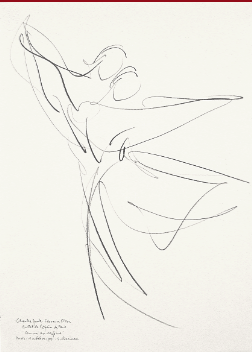
© Stanley Roseman
The artist's Journal includes the page: "My First Days of Drawing the Dance at the Paris Opéra."
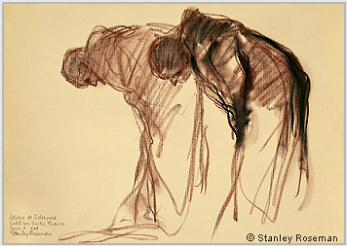

Dr. Walter Koschatzky, Director of the Albertina, made his first acquisition of Roseman's work for the museum in 1978. The eminent Director writes in letter to Ronald Davis to acknowledge receipt of the Roseman drawings: ''I thank you and want to express my conviction that the artist is an outstanding draughtsman and painter to whom much recognition and success are due.''
Roseman became '' 'an honorary member' of the ballet troupe,'' notes the Bibliothèque Nationale de France in a biographical essay on the artist in the exhibition publication Stanley Roseman - Dessins sur la Danse à l'Opéra de Paris (text in French and English), 1996.[1]
In its biographical essay on the artist, the Bibliothèque Nationale de France commends Roseman for his "profound interest in the human condition in portraying different kinds of people, professions, social or artistic groups.''[2] Introduced here and presented on the following pages of the "Biography'' are selections from the artist's work on the performing arts, including the clown in the circus, theatre, and music hall; on the nomadic Saami people of Lappland; and on the monastic life.
Spirit of the Clown
''Circus clowns are one of the glittering joys of all of our lives, whether we are young or old,'' states The New York Times in its superlative review entitled ''Spirit of the Clown'' on Roseman's work at the circus.
In 1989, Roseman returned to the world of the performing arts in Paris, where he received a prestigious invitation to draw the dance at the Paris Opéra.
The artist began drawing clowns at the Ringling Bros. and Barnum & Bailey Circus at Madison Square Garden, New York City, in spring of 1973. The renowned Director of Clowns, Glen "Frosty" Little, seen in the superb portrait, (fig. 5), and the clown troupe were enthusiastic for Roseman's work and brought him into the closed and itinerant circus community. In the private backstage realm called "Clown Alley,'' the clowns gave their time to the artist in intervals between their acts, during intermissions, and before and after the shows.
The New York Times praises the artist for his technical virtuosity: ''Roseman's style is particularly congenial to the subject matter. His vigorous brushstrokes, bold compositions silhouetted against summary backgrounds and his prodigiously bright colors are consistent with the gaiety and fantasy we associate with circus clowns.'' The eminent daily states that the artist's skillful rendering with oil paint on canvas or paper "underscores the fragility of the clowns' impressions. One can sense that their mood might change instantaneously and remove us to another dream world.''
"Paintings by Stanley Roseman glow with a shiny dignity"
The Saami People of Lappland
Roseman's interest in the nomadic Saami took him and his colleague Davis in 1976 beyond the Arctic Circle to the windswept tundra in the interior of Norwegian Lappland. There Roseman painted magnificent portraits of the Saami, a hardy, independent, reindeer herding people who maintain their centuries-old, nomadic way of life in one of the earth's harshest environments.
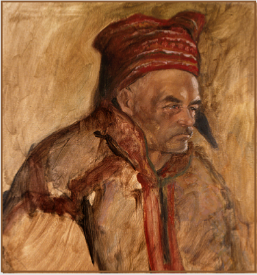
Roseman's fortitude in overcoming challenging physical and climatic conditions in order to pursue his work; his ability to be mobile, as are the Saami; his empathy with his models; and the resultant paintings earned him respect and admiration. Despite the reserve that those nomadic people held towards those outside their community, a rapport of understanding and trust was established between the Saami and the artist.
© Stanley Roseman
Portraiture holds an important place in Roseman's oeuvre. Aftonbladet, Stockholm, in its Sunday magazine cover story on the artist commends Roseman for creating portraits "artistically on a high level as well as accurately expressive of the human dimension.''
The Monastic Life
Roseman embarked in 1978 on what the Los Angeles Times calls ''a sweeping artistic project.'' The artist was invited to live and work in monasteries of the Benedictine, Cistercian, Trappist, and Carthusian Orders - the four monastic orders of the Western Church. Roseman's oeuvre on the monastic life, an ecumenical work brought to realization in the enlightenment of Vatican II, includes monks and nuns of the Roman Catholic, Anglican, and Lutheran faiths in more than sixty monastic communities throughout Europe.
Behind the monastery walls, Roseman painted portraits and made drawings of monks and nuns at prayer, work and study. He drew them taking their meals in silence in the refectory and chanting the Psalms in choir in the early hours of dawn, throughout the day, and at Vigils in the night. Roseman created a monumental and critically acclaimed oeuvre on the monastic life - a life centered on contemplation and prayer.
The National Gallery of Art, Washington, D.C., conserves the superb drawing Two Monks Bowing in Prayer, 1979, from the Benedictine Abbey of Solesmes, France, (fig. 7).
In his youth, Roseman enjoyed a close relationship with his father, who was greatly encouraging of his son's natural talents in art and desire to become an artist. Bernard Roseman, a native New Yorker, was president of the textile company he founded in New York City after serving as a sergeant in the U.S. Army in World War II. An avid opera-, concert-, and theatre-goer, Bernard Roseman provided his son with piano lessons, took him to Broadway musicals, the Metropolitan Opera, ballets, concerts, and the Ringling Bros. and Barnum & Bailey Circus, where the young artist became enamored of the circus clowns. Bernard Roseman taught his son to ice skate and play tennis, two sports at which the artist's father excelled. Stanley Roseman writes:
Early Years
"Although my father was reserved by nature, he had a wonderful sense of humor and a pleasant manner, which endeared him to others. My father was a man of infinite kindness and deep humanity. He fostered understanding and acceptance of people of different races and religions. With a great, natural intelligence, his interests were far-reaching, and he was an avid reader from whom I inherited my love for books.
"From my early years, my father was of great support and encouragement to me in my love for drawing, painting, and sculpting. . . . My father's strong and loving presence in my youth gave me the strength and conviction to pursue my desire to be an artist and follow my own course in life.''
Education at Home and Travels Abroad
Roseman earned a Bachelor of Fine Arts degree from the prestigious Cooper Union for the Advancement of Science and Art, in New York City, and his Master of Fine Arts degree from the equally respected Pratt Institute, also in New York City.
Pursuing his career in New York in the early 1970's, Roseman went his own way counter to the dominant art movements that negated the presence of the human figure and Nature. The artist's portraits, paintings and drawings of the nude, his work on the performing arts, and his landscapes confirm this.
Traveling to Lappland in 1976, Roseman recounts: "I felt akin to Gauguin's leaving a great metropolis and flourishing art center to seek inspiration for one's work among a group of people living in a remote and rural part of the world - for him, native Tahitians, in the South Pacific; for me, nomadic Saami, beyond the Arctic Circle.''
8. Stanley Roseman,
Switzerland, 1981.
Switzerland, 1981.
Landscapes
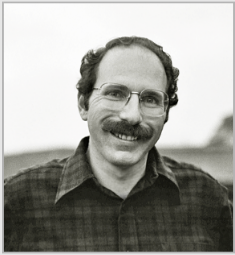
Landscapes constitute an important part of the artist's oeuvre. Roseman paints and draws en plein air throughout the changing seasons - from rolling pastureland awakening with spring growth and windswept seacoasts in summer to woodlands ablaze with autumnal hues and Alpine slopes in winter.
On an early morning in December, 1987, with distant Alpine peaks silhouetted against a golden dawn and a blue-gray mist ascending the hillside, Roseman painted December Morning - View from Chardonne Overlooking Lake Geneva, (fig. 9, above). A month after Roseman painted the breathtaking panorama, the Chief Curator of the Museums of France, François Bergot, acquired December Morning for the Musée des Beaux-Arts, Rouen, of which he was the Director.
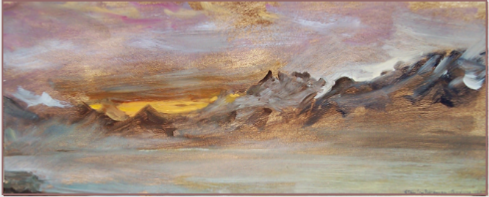
"truly beautiful landscape painting"
- Anzeiger von Saanen, Gstaad
9. December Morning -
View from Chardonne Overlooking Lake Geneva, 1987
Oil on panel, 16 x 39.5 cm
Musée des Beaux-Arts, Rouen
View from Chardonne Overlooking Lake Geneva, 1987
Oil on panel, 16 x 39.5 cm
Musée des Beaux-Arts, Rouen
Yale University's Peabody Museum and Ronald Davis presented in 1977 Roseman's portraits in the exhibition The Saami People of Lappland. That year, the American Bicentennial exhibition Stanley Roseman - The Performing Arts in America concluded its national tour at the Library and Museum for the Performing Arts, Lincoln Center, New York City, from winter to spring. That same year the artist resumed his work on the performing arts, as well as painting and drawing portraits, nudes, and still lifes, and made plans for a return to Europe.
''When I began researching and planning my work on the monastic life," writes Roseman, "my thoughts were towards Europe for monastic life is interwoven with the history and culture of Europe."
You are also cordially invited to visit:
The Performing Arts
As Roseman was completing the drawing, someone placed a hand on his shoulder, and exclaimed ''Bravo!'' The young artist glanced up and saw standing by his side Franco Zeffirelli himself.
At the dress rehearsal of Franco Zeffirelli's production of Verdi's Otello in March 1972, Roseman was seated in the front of the darkened auditorium and drawing by the light coming from the stage. With a lively use of pen and bistre ink, the artist drew the dramatic tenor James McCracken as Otello. A sense of contained emotion is expressed in this impressive drawing, (fig. 3).
''To Stanley, with admiration''
- Franco Zeffirelli
- Franco Zeffirelli
Roseman began his work on the performing arts in 1972 with an invitation from the Assistant General Manager of the Metropolitan Opera, Francis Robinson, who thought highly of the artist's work.
After the dress rehearsal and deeply appreciative of the enthusiasm from Zeffirelli, Roseman asked him if he would autograph the drawing. He gladly did so and included an inscription: ''To Stanley, with admiration, Franco Zeffirelli.'' Being that the eminent director, an artist himself, worked with many celebrated performers in plays and operas by the greatest dramatists and composers, Zeffirelli's esteem for Roseman's draughtsmanship was an auspicious beginning to his work on the performing arts.
3. James McCracken as Otello in the Production by Franco Zeffirelli, 1972
Metropolitan Opera, Otello
Pen and bistre ink, 35 x 27 cm
Collection of the artist
Metropolitan Opera, Otello
Pen and bistre ink, 35 x 27 cm
Collection of the artist
The American bicentennial exhibition Stanley Roseman - The Performing Arts in America comprised the artist's drawings on opera, theatre, and dance and his paintings, drawings, and engravings of the celebrated clowns of the Ringling Bros. and Barnum & Bailey Circus.
The exhibition, produced by Ronald Davis, opened on the eve of the American bicentennial celebrations in December 1975 at the prestigious Curtis Institute of Music in the historic city of Philadelphia, where the Declaration of Independence was adopted by the Continental Congress on July 4, 1776. Thereafter the exhibition toured the United States through 1976.
The Performing Arts in America Exhibition
The Performing Arts in America exhibition concluded its national tour at the Library and Museum for the Performing Arts, Lincoln Center, New York City, winter-spring 1977. Lincoln Center announced the exhibition with a large banner displayed in the Plaza of that world-renowned cultural center which includes the Metropolitan Opera House, New York State Theatre, Philharmonic Hall, and the Library and Museum for the Performing Arts. (See the page below "The Performing Arts in America Exhibition.'')
''The moments Roseman has captured are many and varied,'' wrote The Saratogian, Saratoga, New York, ''and a walk through the exhibition is a trip through what will be our cultural heritage.''
4. Lincoln Center, New York City
Lincoln Center Plaza with the banner announcing the exhibition
Stanley Roseman - The Performing Arts in America
Library and Museum for the Performing Arts, Lincoln Center, 1977
Lincoln Center Plaza with the banner announcing the exhibition
Stanley Roseman - The Performing Arts in America
Library and Museum for the Performing Arts, Lincoln Center, 1977
The Uffizi Gallery, in Florence, acquired the present drawing Charles Jude and Florence Clerc, 1991, along with a selection of the artist's equally superb drawings on the dance at the Paris Opéra. The extraordinary collection of Master Drawings in that world-renowned museum attests to the Florentine Renaissance emphasis on disegno and the primary status of drawing as the foundation of the visual arts. The document of acquisition enumerates ''four drawings by Stanley Roseman inspired by the dance'' and states that the works ''will enrich the collection of the Gabinetto Disegni e Stampe degli Uffizi."
With flowing, nuanced pencil lines on paper, Roseman renders the graceful dance movements of those two great star dancers Charles Jude and Florence Clerc. Their arms outstretched and their heads inclined, they dance together in beautiful harmony to John Field's Nocturne no. 4 in A major. As Florence Clerc told the artist, ''dancing in this pas de deux is just as one breathes'' - for it was she who had given the title to the choreographic work Comme on respire.
Paris
In 1978, Roseman and Davis began extensive travels to monasteries in England, Ireland, and Continental Europe. Roseman's work on the monastic life brought the artist and his colleague to Switzerland in 1981. From there, they made returns to monasteries where they had sojourned before and, with additional invitations, sojourned with other monastic communities, thus furthering the geographic and ecumenical scope of the work to include communities of Anglican and Lutheran monks and nuns, as well as those of the Roman Catholic faith. In 1983, the Graphische Sammlung Albertina presented the exhibition Stanley Roseman - Zeichnungen aus Klöstern (Drawings from the Monasteries). The exhibition of Roseman's drawings at the Albertina brought great prestige to the artist and his work.
At the Paris Opéra
10. Stanley Roseman drawing the dance
from the wings of the stage
of the Paris Opéra.
from the wings of the stage
of the Paris Opéra.
Paris Opéra star dancer Florence Clerc contributed an eloquent testimonial for the publication by the Bibliothèque Nationale de France for its exhibition Stanley Roseman - Dessins sur la Danse à l'Opéra de Paris, 1996.
The Bibliothèque Nationale de France affirms that Roseman's oeuvre on the dance "gives an answer to the challenge of expressing movement in a single pictorial image."
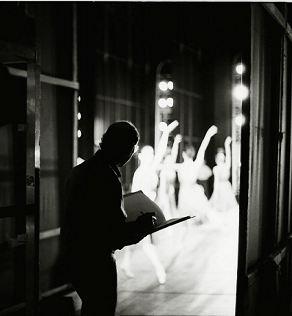
Photo © Ronald Davis
At the Paris Opéra, Roseman drew at rehearsals in the dance studios and at the pré-générale and répétition générale (dress and final dress rehearsals) in the auditorium. Having become '' 'an honorary member' of the ballet troupe'' and in recognition of the artist's "great talents as a draughtsman," to quote again the Bibliothèque Nationale de France, Roseman was given the extraordinary privilege to draw during performances, night after night, from the wings of the world-famous stage of the Paris Opéra.
''The first time I saw Stanley Roseman, I was waiting in the wings to make my entrance on stage. I saw him make several broad pencil strokes and turn his pages at full speed. I was very interested, as I love drawings, but I must admit I was a little skeptical. At the end of the performance, I crossed the stage towards him to see the results. I was astounded! He had captured the movement in several seconds. Since then I have seen many of his drawings; I recognize immediately the work, the passage, and the interpretation. For me, his drawings are dance itself.''[4]
- Florence Clerc
Star Dancer of the Paris Opéra
Star Dancer of the Paris Opéra
Photo © Ronald Davis
© Stanley Roseman
Biography continues
at bottom of this Page 1
with links to pages:
2. World of Shakespeare
3. The Performing Arts
in America Exhibition
4. Spirit of the Clown
5. The Saami People
of Lappland
6. The Monastic Life
7. Portraits
8. The Nude
9. Landscapes
10.Still Lifes
at bottom of this Page 1
with links to pages:
2. World of Shakespeare
3. The Performing Arts
in America Exhibition
4. Spirit of the Clown
5. The Saami People
of Lappland
6. The Monastic Life
7. Portraits
8. The Nude
9. Landscapes
10.Still Lifes
BIOGRAPHY CONTINUED
